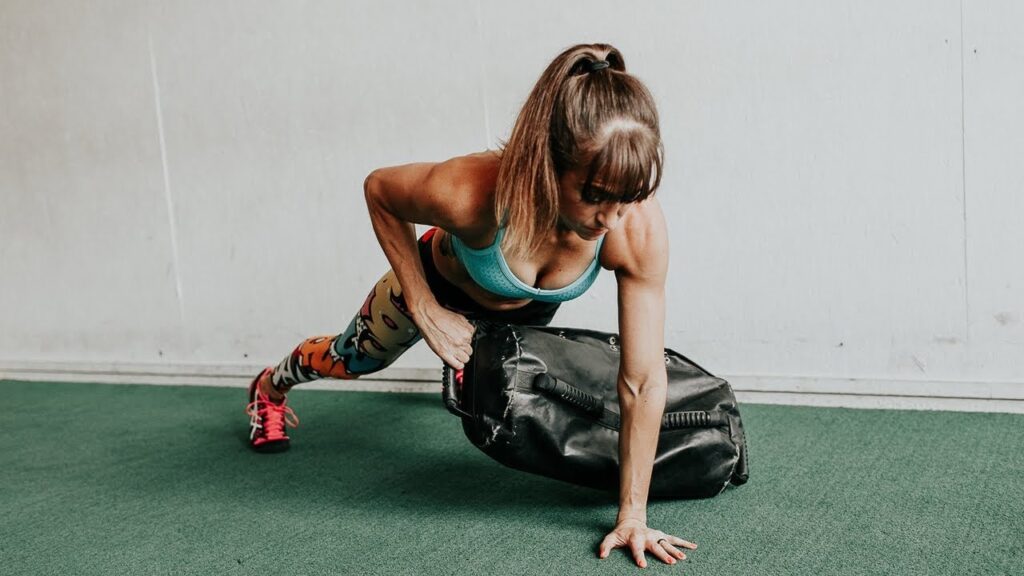Sandbag Workout – When people think of strength training, they often picture barbells, dumbbells, or resistance machines. But there’s a gritty, underused tool that delivers real-world results without needing a fancy gym or high-tech setup: the sandbag.
A sandbag workout might look simple, but it’s one of the most effective ways to build strength, power, stability, and endurance all in one go.
Whether you’re a fitness enthusiast, an athlete, or just looking to break out of your training plateau, incorporating sandbag workouts into your routine can bring a powerful new dimension to your fitness journey.
What is a Sandbag Workout?
At its core, a sandbag workout involves lifting, carrying, pressing, or throwing a weighted bag filled with sand. It sounds straightforward, but there’s a catch—the weight constantly shifts as you move. That shifting load forces your muscles to engage in ways that traditional weights don’t.
Unlike a barbell that distributes weight evenly, sandbags are awkward, unpredictable, and unstable. This makes each movement more challenging and functional, demanding coordination, core engagement, and overall body strength.
Benefits of Sandbag Training
1. Functional Strength
Sandbags mimic real-life loads. When you pick up a sandbag, your body moves the way it does when carrying groceries, lifting a child, or doing manual labor. It doesn’t isolate muscles—it integrates them. The result? You build strength you can actually use in daily life.
2. Core Activation
Every movement with a sandbag forces your core to stabilize. Whether you’re pressing it overhead or carrying it across your shoulders, your abs, obliques, and lower back are constantly working to keep you balanced.
3. Improved Grip Strength
The shifting weight and varied handles challenge your grip in a way dumbbells and machines don’t. Over time, your hands, wrists, and forearms grow stronger—an often overlooked aspect of total-body fitness.
4. Versatility and Accessibility
Sandbags are affordable, portable, and can be used anywhere. You can train in your living room, backyard, or at a park. You don’t need a gym membership or a room full of equipment. And if you’re on a budget, you can even make your own DIY sandbag.
5. Cardio and Strength Combined
Sandbag training isn’t just for brute strength. Exercises like sandbag cleans, thrusters, or bear hug carries elevate your heart rate while building muscle—making it a fantastic full-body conditioning tool.
How to Choose or Build a Sandbag
There are commercial sandbags with durable canvas and multiple handles, ideal for structured workouts. But you can also create one using a duffel bag, contractor bags, and play sand. Make sure it’s securely packed to prevent leaks.
For safety, start with a weight that challenges you but still allows proper form—around 25–50 lbs (11–23 kg) for beginners.
Essential Sandbag Exercises
Let’s look at some foundational movements that target multiple muscle groups and can be modified to suit all levels.
1. Sandbag Deadlift
Muscles worked: Hamstrings, glutes, back, core
How to: Stand over the sandbag, squat down with a flat back, and grip the handles. Stand up by pushing through your heels, then lower back down.
2. Sandbag Clean and Press
Muscles worked: Legs, shoulders, arms, core
How to: Lift the sandbag explosively from the ground to your chest (clean), then press it overhead. This is a great power move.
3. Sandbag Bear Hug Squat
Muscles worked: Quads, glutes, core, arms
How to: Hold the sandbag tightly against your chest, then perform squats. The hugging position challenges your arms and core as you stabilize the weight.
4. Sandbag Overhead Carry
Muscles worked: Shoulders, traps, core, legs
How to: Press the sandbag overhead and walk for distance or time. It’s simple but surprisingly tough.
5. Sandbag Lunge (Front Load or Shoulder Carry)
Muscles worked: Quads, hamstrings, glutes, core
How to: Hold the sandbag in front of you or across your shoulder and step into lunges. This uneven load improves stability and coordination.
6. Sandbag Drag
Muscles worked: Arms, shoulders, back, grip
How to: Place the bag on the ground and drag it backward or forward using one or both hands. It simulates pulling resistance and builds full-body grit.
7. Sandbag Get-Up
Muscles worked: Core, shoulders, hips, legs
How to: Start lying down with the sandbag on your chest. Stand up while holding it close, then return to lying down. It’s excellent for coordination and core control.
Sample Full-Body Sandbag Workout (Beginner to Intermediate)
Warm-Up (5 minutes):
- Jumping jacks – 1 min
- Arm circles – 1 min
- Bodyweight squats – 1 min
- Lunges – 1 min
- Core twists – 1 min
Workout (3 rounds, rest 1 min between rounds):
- Sandbag Deadlift x 12
- Bear Hug Squat x 10
- Shoulder Carry Lunge x 10 (5 each side)
- Clean and Press x 8
- Overhead Carry – 30 seconds
- Sandbag Drag – 20 meters
Cool Down (5 minutes):
- Gentle stretching
- Deep breathing
- Focus on quads, hamstrings, and shoulders
Tips to Get the Most Out of Sandbag Training
- Focus on form: The unstable load increases injury risk if your form is poor. Start light and build up gradually.
- Mix it with other training: Combine sandbag days with traditional lifts, bodyweight training, or cardio to keep your fitness balanced.
- Stay consistent: Like any training method, sandbag workouts deliver best when done regularly.
- Hydrate: Carrying, pressing, and lifting awkward weight gets your heart rate up fast—stay hydrated, especially when training outdoors.
Who Should Use Sandbags?
Sandbag training isn’t just for CrossFit athletes or military personnel. It’s for anyone looking to build real, usable strength:
- Beginners: You don’t need experience to get started, just basic fitness.
- Busy adults: Quick full-body sessions with a sandbag are time-efficient.
- Athletes: Great for developing explosive power, stability, and endurance.
- Older adults: With proper supervision, sandbags can improve functional movement and balance.
Final Thoughts
Sandbag workouts are more than just a fitness trend—they’re a practical, versatile, and incredibly effective way to train.
They strip away the noise of machines, mirrors, and metrics, bringing you back to raw, functional movement that translates directly to real life.
Whether you’re pushing for more strength, better endurance, or greater stability, adding sandbag training to your routine could be the shift your body needs. It’s not fancy, but it’s fierce—and it works. So grab a bag, fill it with sand, and let your muscles feel the difference.








